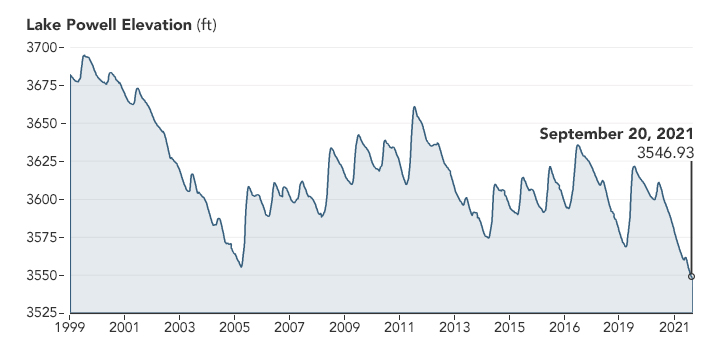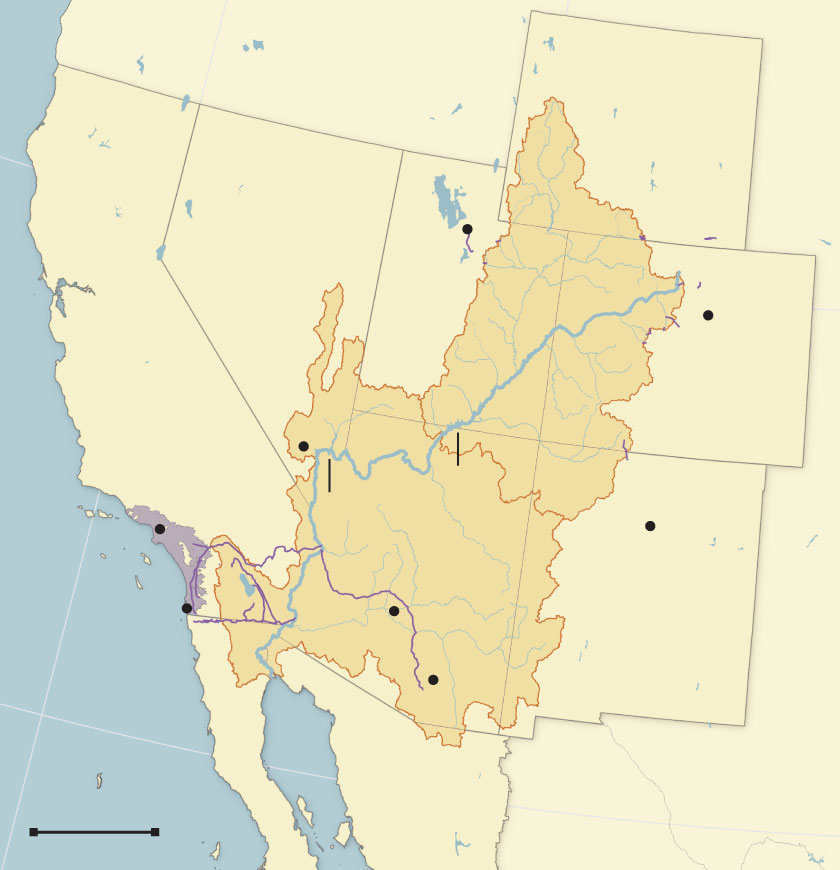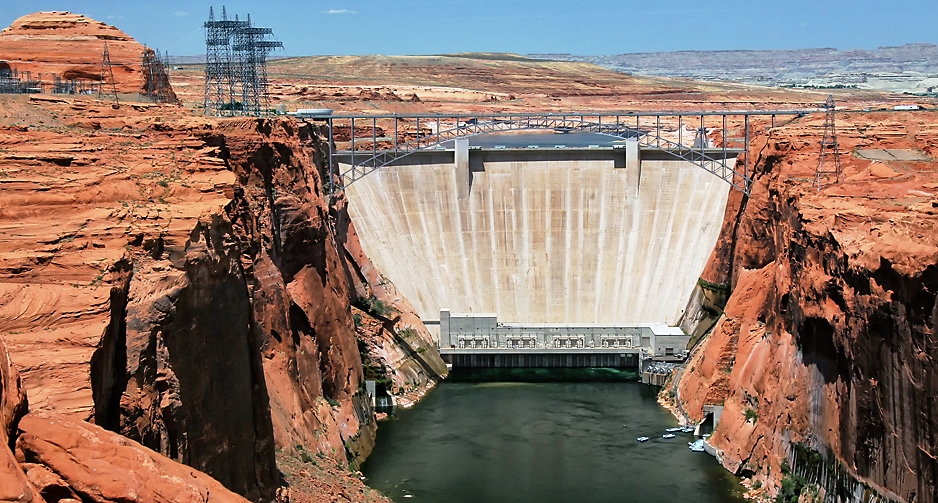Nationwide there have been more than 1,300 dams have been removed and there are environmental movements to extract many more over the next decade as the country explores the possibilities of the natural flow of rivers that were once obstructed in the name of progress. Will the Glen Canyon Dam be removed?
Glen Canyon Dam won’t be removed soon because of its importance for:
- Hydroelectric power
- H2O storage for irrigation
- Flood control
- Local Economic impacts
- Recreation opportunities at Lake Powell
- H2O supply for southwestern states
- Environmental concerns/legal complexities
- Significance to Native American tribes
Authorized by Congress, the Colorado River Storage Project Act in 1956 initiated the construction of Glen Canyon Dam, with the first dynamite blast when President Dwight D. Eisenhower pressed a telegraph key from Washington D.C. to set off the explosion signaling the beginning of construction.
Introduction:
In the heart of northern Arizona, nestled amidst the rugged terrain of the Colorado Plateau, stands a monument to human ingenuity and the relentless pursuit of harnessing nature’s forces for the betterment of society. The Glen Canyon Dam, a towering sentinel of concrete and steel, rises majestically from the depths of the Colorado River, its imposing presence a testament to the transformative power of water management and hydroelectric technology.
Since its completion in 1963, the Glen Canyon Dam has stood as a symbol of human achievement, creating the vast reservoir of Lake Powell and unleashing a myriad of opportunities for recreation, energy production, and water resource management in the arid landscapes of the American Southwest. But beyond its physical stature lies a complex narrative of environmental impact, cultural significance, and the ongoing debate over the balance between progress and preservation.
Glen Canyon Dam
Glen Canyon is one of America’s — and the world’s — greatest natural wonders. John Wesley Powell named Glen Canyon during his 1869 survey, and described it as a “land of beauty and glory.” Edward Abbey wrote that Glen Canyon was “a portion of earth’s original paradise.” Wallace Stegner judged the Glen to be “potentially a superb national park.”
 The Glen Canyon Dam at 710 feet is the 2nd highest concrete arched dam in the United States next only to The Hoover Dam which stands at 726 ft. tall. The Glen Canyon creates 26.2 million acre-feet of water storage capacity in Lake Powell.
The Glen Canyon Dam at 710 feet is the 2nd highest concrete arched dam in the United States next only to The Hoover Dam which stands at 726 ft. tall. The Glen Canyon creates 26.2 million acre-feet of water storage capacity in Lake Powell.
The Dam divided up the Colorado River’s water between 7 states through an agreement called the Colorado River Compact first ratified in 1922 and then signed into law in 1956, separating the basin into an Upper Basin (Wyoming, Utah, Colorado & New Mexico) received 7.5 million acres/feet of water, and the Lower Basin states (Arizona, Nevada & California) also received the same.
It would take 17 years to fill beginning in 1963 and was finally filled on June 22, 1980, reaching an elevation of 3,700 feet above sea level with a total capacity of over 26 million acre-feet of water. In the end, the reservoir inundated 186 miles of a pristine canyon with the waters of the Colorado River.
The Dam produces power with eight generators providing a good chunk of electrical demands needed by the Western US with a total capacity of 1,320 megawatts, Glen Canyon Powerplant produces around five billion kilowatt-hours of hydroelectric power annually which is then distributed by the Western Area Power Administration to Wyoming, Utah, Colorado, New Mexico, Arizona, Nevada, and Nebraska.
The Glen Canyon Dam which is managed by the National Park Service provides numerous water recreational activities to millions of people every year besides a long-term carryover water storage that allows the Upper Basin states of Wyoming, Colorado, New Mexico, and Utah to use their share of the Colorado River while also providing the delivery of water to the Lower Basin states of Arizona, California, and Nevada.
Glen Canyon Before the Dam
Before the construction of the dam, Glen Canyon was a wonderland of gorges, spires, cliffs, and grottoes of the biological heart of the Colorado River, with more than 79 species of plants, 189 species of birds, and 34 species of mammals and a cultural treasure, with more than 3,000 ancient ruins.

With the construction of the Glen Canyon Dam came negative changes in the ecology and geology of the Colorado River that affected this natural treasure of the Grand Canyon. Numerous plants and animals were drowned under Lake Powells’ waters.
Whether the 2nd largest dam and reservoir in the U.S. were worth the price is a question many are asking years later. The story of the Glen Canyon Dam is the story of the battle between Conservation and Preservation. Nowhere else in the country is water as important as in the West for its development and existence. Water is more valuable than land here where every drop is as necessary as blood is for human life.
In the decades to come, many serious questions would arise about the dam’s necessity and viability. Before the Dam was built sediment carried by warm water flowed down the Colorado River and deposited itself in the Grand Canyon creating sandbars and habitats for native species.
The Dam releases much cooler water without sediment destroying natural habitats and wetlands downstream from the Glen Canyon Dam and along the river. When the Colorado River Compact was agreed upon the river’s flows were historically high overestimating the amount of water available and underestimating the amount of development. Climate Change-Drought and Overdevelopment lead us to where we are now.
While the reservoir recedes, a miraculous transformation is slowly taking place. Many years of water shortages and drought on the Colorado River have effectively begun to re-expose the canyons of the Glen. The world-famous landscapes and unique ecosystems of Glen Canyon are finally coming back to life, and now is the time for the protection and continued restoration of these beautiful lands. What members of the Glen Cayon Institute are calling “second chance”
The U.S. Bureau of Reclamation opened up the flow down the Colorado River and downstream to Lake Mead on April 24, 2023, sending a gush of water at 39,500 cubic feet per second (cfs) and lasting 72 hours. The desired effect: push sand and sediment out of the riverbed below the dam to build up sandbars further down the river. Those sandbars provide camping spots for people along the river.
Will Glen Canyon Dam ever be removed

For decades Dams like the Glen Canyon provided cheap electric power besides a steady stream of revenue to help with the construction maintenance and operational costs of this giant structure.
Now that the reservoirs at Lake Powell and Lake Mead are at the lowest levels since they were built and continue to drop close to Deadpool, many are thinking about the 22-year drought and how it will affect the future.
Glen Canyon Dam is operating at about 60% of its hydroelectric design capacity. Rated for 1,320 megawatts which is roughly the size of a large fossil fuel plant, according to the Burea of Reclamation, the Dam is now only capable of producing 800 megawatts.
Glen Canyon Powerplant produces around five billion kilowatt-hours of hydroelectric power annually which is distributed by the Western Area Power Administration to Wyoming, Utah, Colorado, New Mexico, Arizona, Nevada, and Nebraska.
This loss of hydroelectric production affects the demands of more than 5 million energy customers. It increases greenhouse gas emissions associated with the generation of electricity that hydropower provides and could contribute to blackouts and stress on the power grid in the western states.
Water managers, some scientists, and activists would like to see the dam removed in order to drain Lake Powell and feed a drought-stricken Lake Mead, a water source for major cities including Las Vegas and Phoenix. Draining Lake Powell would also return Glen Canyon to its former, natural glory.
As Lake Powell Reservoir has lowered miles of the main canyon hundreds of miles of side canyons have been exposed for the first time in years. Ecosystems are starting to heal. People are beginning to explore the emerging backcountry once again. Scientific studies predict that without the reservoir, sediment deposits in the main channel upstream of the dam could be flushed out in as little as five years
There is evidence that years of damage to the Grand Canyon’s ecosystems may be substantially reversed. Temporary management changes that mimic natural river flows have partially replenished sediments and endangered fish and animal habitats that were once damaged.
Dams are removed by different methods:
- Notch & release method-slow-ecological method-most common way
- Rapid release approach-quickest-less expensive
- Dig & dewater approach-emptying the entire reservoir & dispose of remains-$$
- Retained sediment method or creek must be rerouted around the dam site ..…………………………………………………………………………………….. Read more
Conclusion:
If the Glen Canyon is drying up and can’t supply enough water to Lake Mead and can’t make enough Hydroelectric power that it was built to do, then what purpose does it fill? Could it be taken down like the thousands of other Dams in the country that have outlasted their reason to exist?
Scientists, H2O managers & activists would like to see the Dam removed draining Lake Powell & directly feeding the Colorado River into Lake Mead a major source of H2O for Las Vegas & Phoenix, & returning Glen Canyon to its natural glory but too many people are dependent on the hydropower it provides.

References: Glen Canyon Institute –Facing the future of a shrinking Lake Powell
Bureau of Reclamation –The Glen Canyon Unit
FAQ’s
- What is the purpose of the Glen Canyon Dam? The primary purposes of the Glen Canyon Dam are water storage, hydroelectric power generation, and flood control. It helps regulate the flow of the Colorado River, provides water for irrigation and municipal use, generates electricity, and helps prevent downstream flooding.
- How tall is the Glen Canyon Dam? The Glen Canyon Dam stands at a height of 710 feet (216 meters) above the Colorado River’s bedrock.
- What is Lake Powell, and how was it formed? Lake Powell is a large reservoir created by the impoundment of the Colorado River behind the Glen Canyon Dam. It extends upstream into southern Utah and has a storage capacity of over 24 million acre-feet of water. Lake Powell was formed as the Glen Canyon Dam filled with water, inundating the scenic Glen Canyon and creating a vast body of water for recreational use and water storage.
- How much electricity does the Glen Canyon Dam generate? The Glen Canyon Dam’s power plant has an installed capacity of over 1,300 megawatts, making it a significant source of hydroelectric power in the region. It generates electricity to meet the needs of several southwestern states.
- What environmental impacts are associated with the Glen Canyon Dam? The construction of the Glen Canyon Dam and the formation of Lake Powell had significant environmental impacts, including the inundation of Glen Canyon, the alteration of downstream ecosystems, and changes in the flow regime of the Colorado River. These impacts have affected native species, archaeological sites, and scenic landscapes.
- Is the Glen Canyon Dam safe? The safety of the Glen Canyon Dam is continuously monitored and evaluated by engineers and dam safety experts. Ongoing maintenance and rehabilitation efforts are undertaken to ensure the dam’s structural integrity and resilience against potential hazards such as earthquakes and large floods.
- Can visitors tour the Glen Canyon Dam? Yes, guided tours of the Glen Canyon Dam are available for visitors. These tours provide insights into the dam’s history, construction, and operation, offering a behind-the-scenes look at one of the engineering marvels of the American West.
- How does the Glen Canyon Dam affect downstream water users and ecosystems? The Glen Canyon Dam regulates the flow of the Colorado River, which impacts downstream water users, ecosystems, and riparian habitats. Water releases from the dam are managed to meet various needs, including agriculture, municipal supply, hydropower generation, and environmental conservation, but balancing these competing demands can be challenging.
